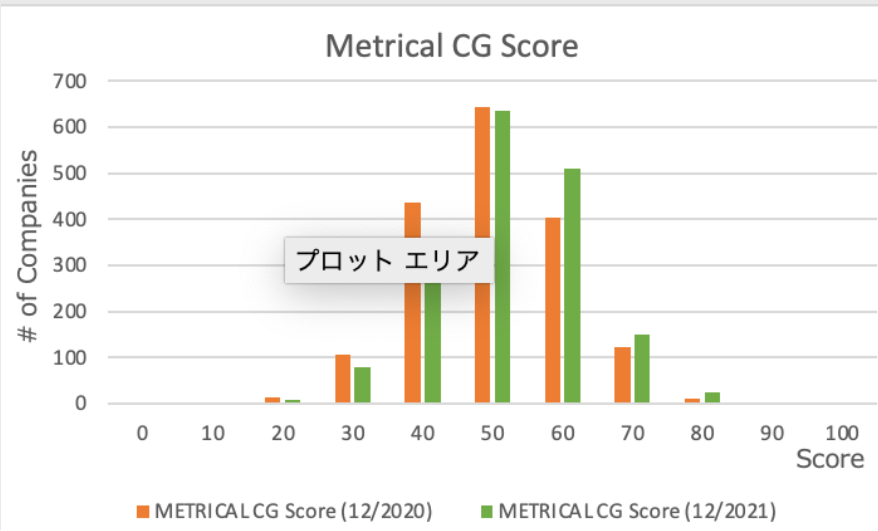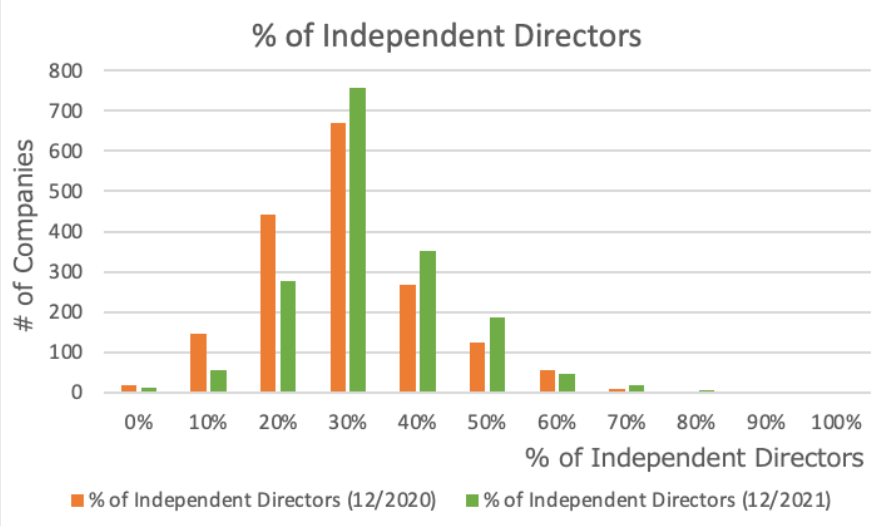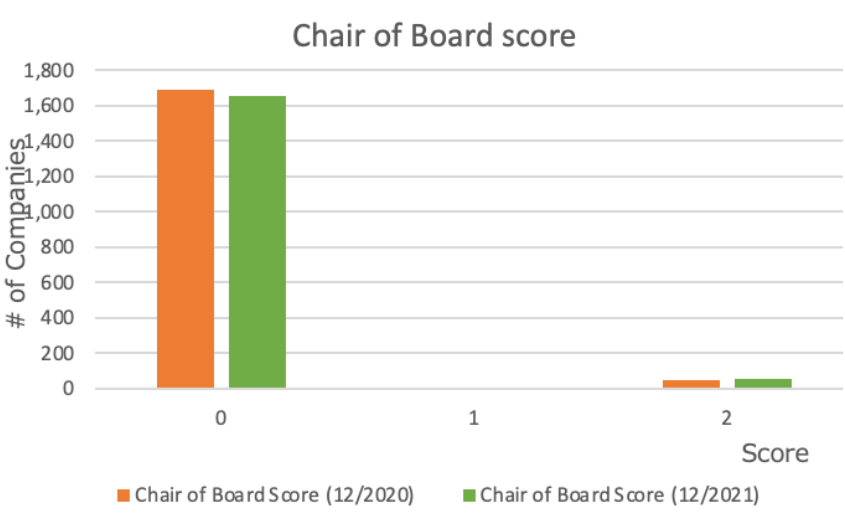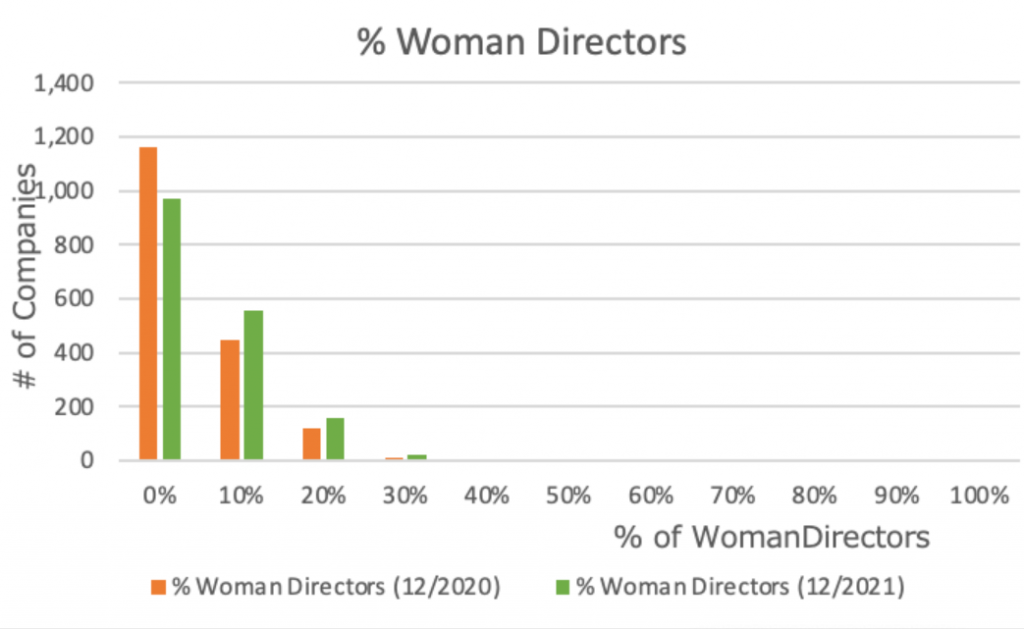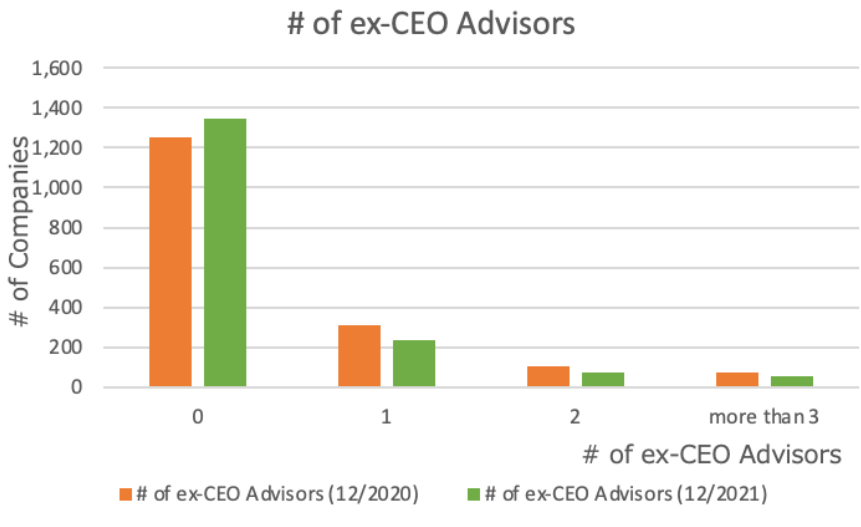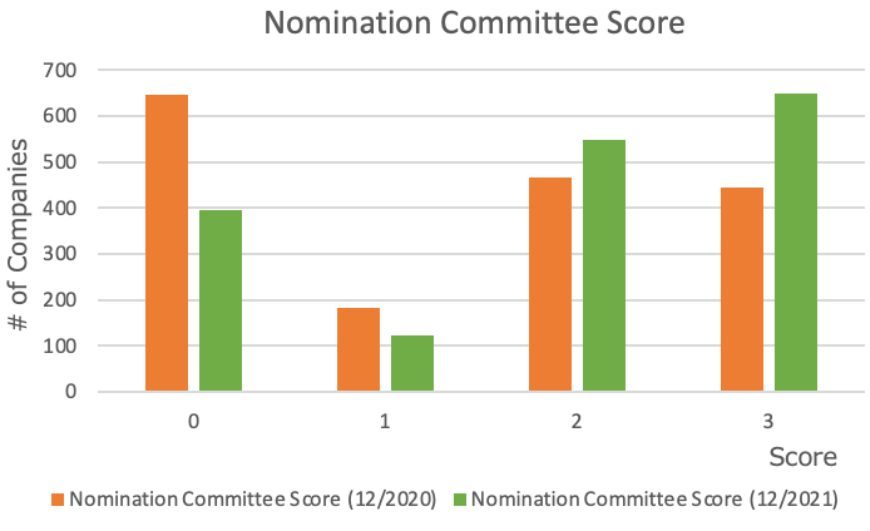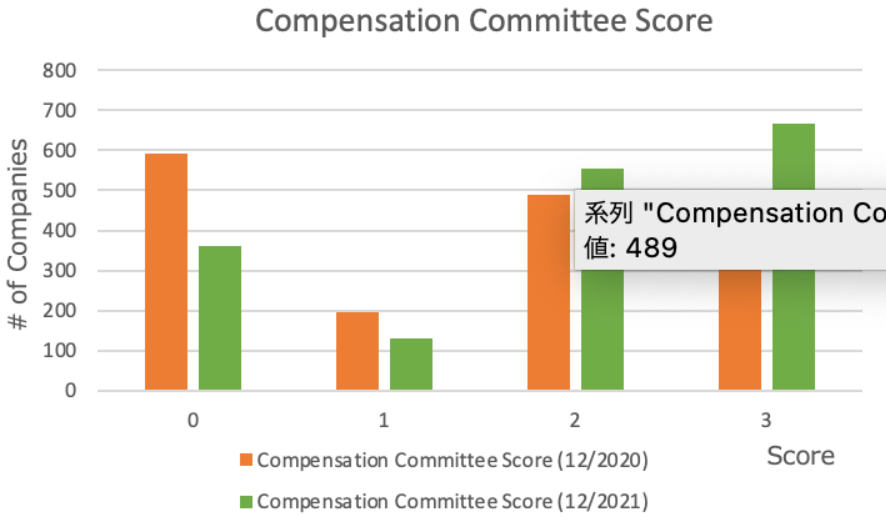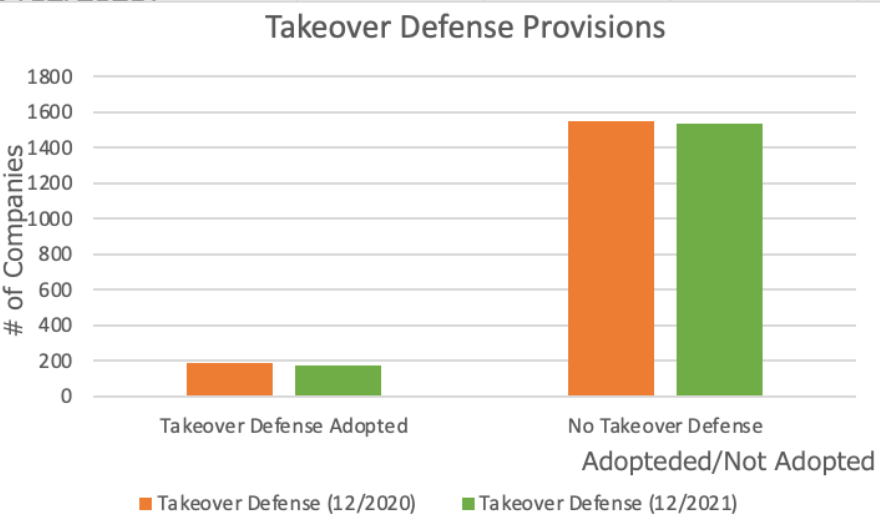
Metrical updates its corporate governance evaluations every month for approximately 1,700 companies listed on the 1st Section of the Tokyo Stock Exchange with market capitalization exceeding approximately 10 billion yen. 2021 saw the revision of the Corporate Governance Code in line with the reorganization of the TSE’s market segments in April 2022. It is expected that initiatives to enhance the corporate governance of listed companies will also move forward. I would like to take a look at how far corporate governance has improved as a result of these efforts, with numbers.
The chart below shows Metrical’s evaluation of each criteria in December 2020 and their changes in December 2021, showing how far the corporate governance initiatives of listed companies have improved over the past year. Let’s take a look at them in order.
The first chart shows the distribution of the Metrical CG score, which is an overall assessment of a listed company across a number of corporate governance criteria. The distribution of the green bars in December 2021 is higher than that of the orange bars in December 2020, indicating that the score has shifted to the right. It can be assumed that listed companies have made progress in their corporate governance efforts, partly due to the revision of the Corporate Governance Code. Let’s take a closer look at the details below.
The next chart shows the percentage of independent directors. The percentage of independent directors to the total number of directors is a key indicator of board practices, and previous analysis has shown that it is closely related to the performance indicators of listed companies. Since the revised Corporate Governance Code requires companies listed on the prime market to have at least 1/3 of their board members as independent directors, it was expected that the proportion of independent directors would increase in 2021. Although the highest percentage is still in the 30% range, the distribution of the green bars in December 2021 has shifted to the right with a higher score compared to the distribution of the orange bars in December 2020, indicating that this ratio has improved. The number of companies with the ratio of 50% or higher has also increased compared to the previous year, but again, the overall number is overwhelmingly small. Our analysis so far has also confirmed the positive impact on the performance of listed companies, so we can assume that the positive effect on corporate governance practices really starts to appear when the ratio rises above 50%. We will have to see if this ratio continues to improve in the future.
The chart below shows the score for who is chairing the board meeting. The chart below shows the score for who chairs the board of directors, with a score of 2 when an independent director chairs the board. We can see that in the overwhelming majority of companies, the board is chaired by an internal executive director, and there is little change in the distribution in December 2021 compared to December 2020. This score, along with the independent director ratio above, is considered an important measure of board practices, but unlike the independent director ratio, there has been little improvement in this ratio. This shows a very unfortunate trend that listed companies are not taking action on items that were not related to the revision of the Corporate Governance Code.
The next chart shows the ratio of female directors. The ratio of female directors has also improved slightly in December 2021 compared to December 2020. However, the number of companies with this ratio exceeding 30% is extremely small. Although the revised Corporate Governance Code mentions the importance of diversity, the degree of improvement has been limited due to the lack of numerical targets. This ratio has been analyzed so far and its positive impact on the performance of listed companies has been confirmed. The fact that the Japanese government has postponed its goal of increasing the percentage of female managers (which is broader than the percentage of female directors) to 30% for the next 10 years confirms that improvement in this ratio is lagging behind.
The following chart shows how many people remain in the company as ex-CEO advisors or counselors after stepping down as CEO. This uniquely Japanese practice is of course a negative corporate governance practice. It is unclear whether all listed companies disclose this data in their corporate governance reports, but the number of ex-CEO advisors and counselors has improved slightly in December 2021 compared to December 2020.
The following chart shows the Nominating Committee Score, which evaluates whether a nominating committee has been established, whether a majority of the members of the committee are independent directors, and whether the committee is chaired by an independent director. The revised Corporate Governance Code requires companies listed on the prime market to have a nominating committee, even if it is a voluntary committee, and a majority of the members of the committee must be independent directors, so it was expected that the score would increase in 2021. The distribution of the green bars in December 2021 shifts to the right with a higher score than the distribution of the orange bars in December 2020, indicating that a voluntary nominating committee period was established. There was also an increase in the number of cases where the majority of members of the committee were independent directors. On the other hand, since the revised Corporate Governance Code does not require companies listed on the prime market to have a profile of the chairman of the committee, there are many cases where the committee is chaired by an inside executive director. As the number of independent directors on the board is less than a majority, we need to pay attention to whether the nomination committee is functioning effectively.
The next chart shows the compensation committee score, which indicates whether the company has a Compensation Committee, whether the majority of the members of the committee are independent directors, and whether the committee is chaired by an independent director. Since the revised Corporate Governance Code requires companies listed on the prime market to have a compensation committee, even if it is a voluntary committee, and a majority of the members of the committee must be independent directors, the score was expected to increase in 2021. The distribution of the green bars in December 2021 shifts to the right with a higher score than the distribution of the orange bars in December 2020, indicating that a voluntary compensation committee has been established. There was also an increase in the number of cases where the majority of members of the committee were independent directors. Compared to nominating committees, compensation committee practices are more progressive than those of nominating committees, as there seems to be less of a problem between inside executive directors and independent directors in setting up and running compensation committees.
The next chart shows takeover defense provisions. We do not see any significant changes over the past year, as many listed companies have already disclosed that they will not adopt the advance warning takeover defense provisions. It may be difficult for companies that still adopt this anti-takeover provision to abolish this provision unless there is some trigger.
In the next article, I would like to discuss other evaluation criteria.
Please see detail research the following links.
http://www.metrical.co.jp/
Please feel free to contact the below email address if any interest or query.
Aki Matsumoto, CFA
Executive Director
Metrical Inc.
akimatsumoto@metrical.co.jp
http://www.metrical.co.jp/jp-home/

